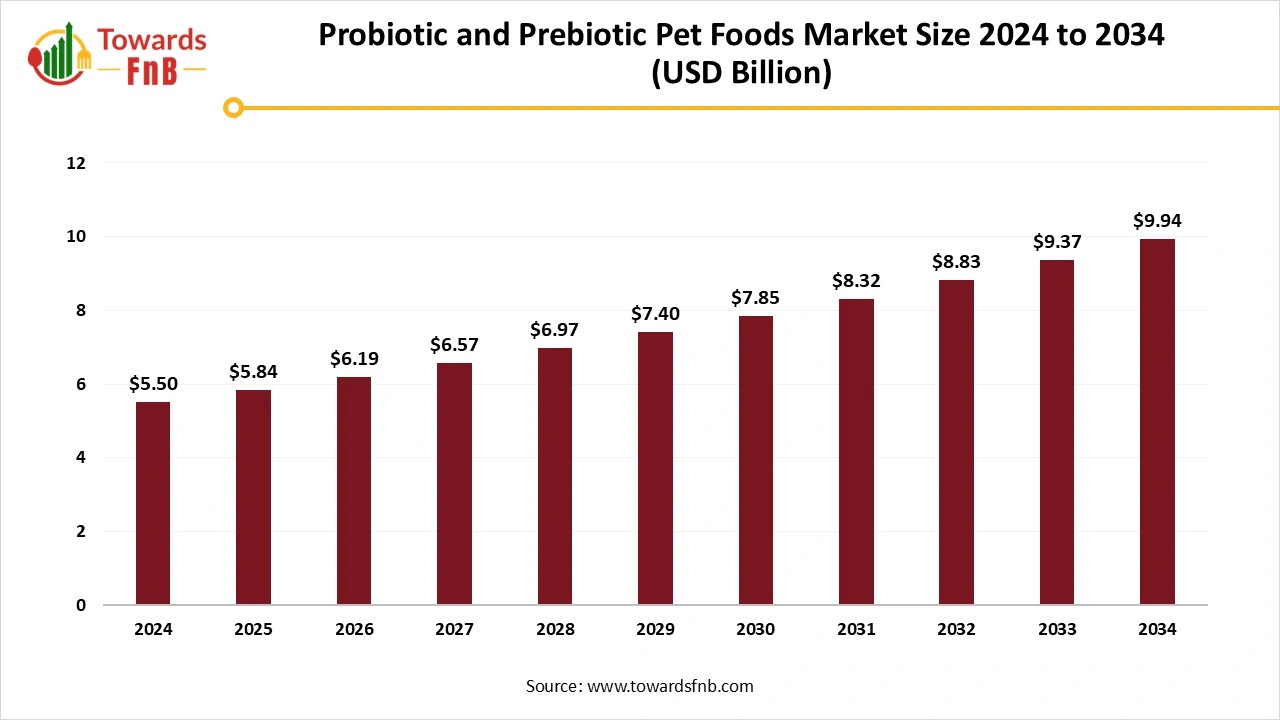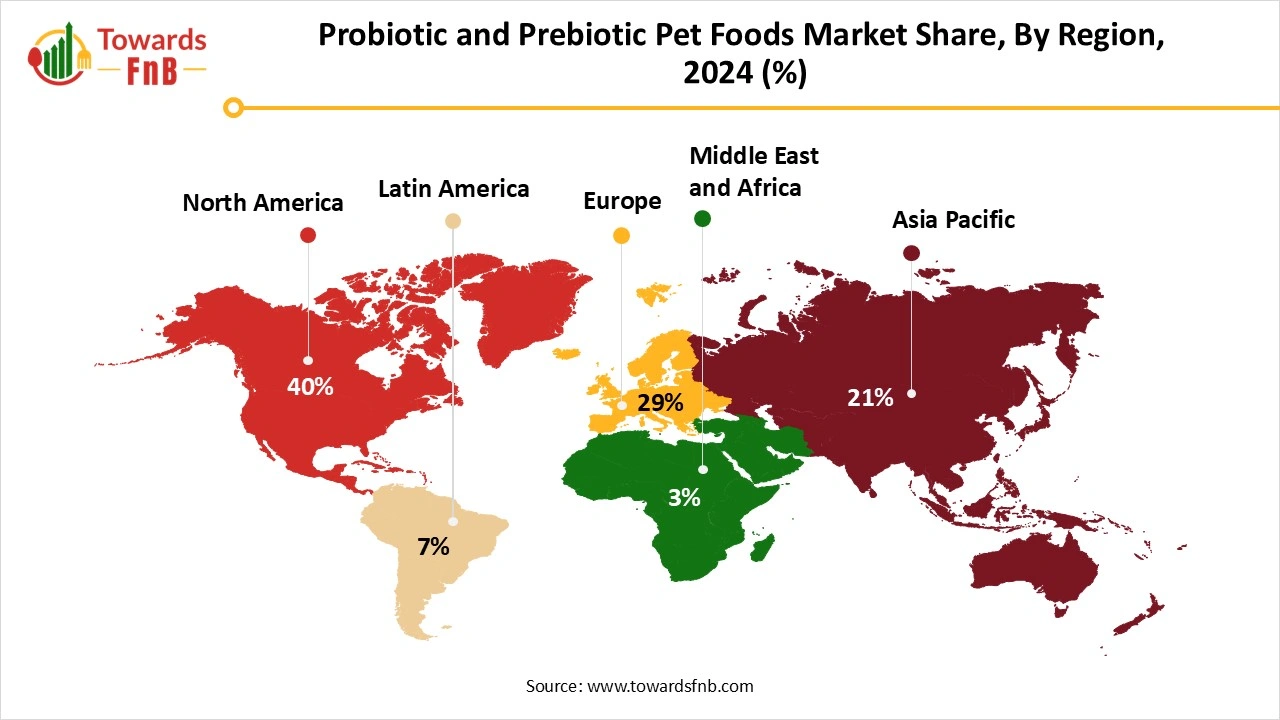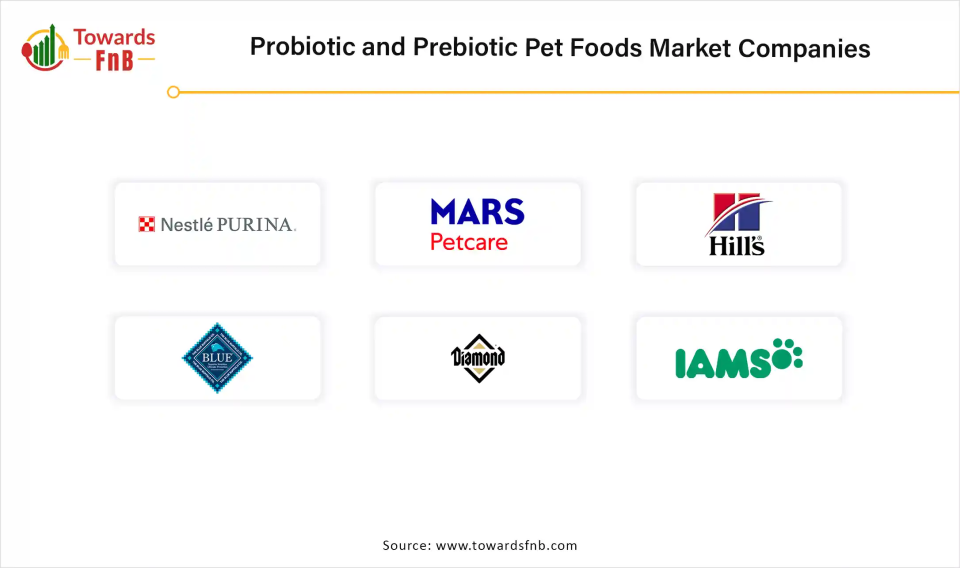November 2025
The global probiotic and prebiotic pet foods market size reached at USD 5.50 billion in 2024 and is anticipated to increase from USD 5.84 billion in 2025 to an estimated USD 9.94 billion by 2034, witnessing a CAGR of 6.1% during the forecast period from 2025 to 2034. Growing pet humanization and growing awareness among pet owners about gut health of the pet expanding the market.

| Study Coverage | Details |
| Growth Rate from 2025 to 2034 | CAGR of 6.1% |
| Market Size in 2025 | USD 5.84 Billion |
| Market Size in 2026 | USD 6.19 Billion |
| Market Size by 2034 | USD 9.94 Billion |
| Largest Market | North America |
| Base Year | 2024 |
| Forecast Period | 2025 to 2034 |
| Regions Covered | North America, Europe, Asia-Pacific, Latin America, and Middle East & Africa |
The probiotic & prebiotic pet foods market refers to the growing category of pet food products that contain live microorganisms (probiotics) or prebiotics, which are ingredients that support the growth and activity of beneficial microorganisms in the pet's gastrointestinal tract. These foods are specifically formulated to enhance digestive health, improve immune function, and provide overall wellness benefits to pets, including dogs, cats, and other companion animals.
Probiotics are beneficial bacteria or yeasts that help maintain a healthy gut microbiome, improving digestion and absorption of nutrients. Prebiotics are non-digestible food ingredients that stimulate the growth and activity of beneficial bacteria, thus supporting a healthy digestive system.
The market is driven by increasing awareness among pet owners about pet health, the growing humanization of pets, and rising demand for natural, functional ingredients in pet food.
The increasing emphasis on gut health in pet food highlights innovative possibilities in the worldwide pet food industry. Improvements in probiotic and prebiotic formulations create chances for more specifically tailored solutions that match pets' individual requirements. Nutritional approaches that benefit the gut microbiome, along with new technologies, can assist pet owners in delivering the best care. Pet owners are progressively looking for natural, organic, and clean-label prebiotic products, creating opportunities for innovative new offerings. These preferences reflect the larger trend among consumers towards sustainable and health-focused buying decisions. Researchers are concentrating on creating tailored probiotic treatments according to a person's gut microbiota makeup.
A key hurdle in the probiotic & prebiotic pet food sector is maintaining the stability and viability of probiotic strains during the processing and storage of animal feed. High temperatures (typically exceeding 80°C) and pressure during processing and pelleting can affect vulnerable probiotic organisms and their effectiveness by the time animals ingest them. Regardless of these circumstances, probiotics must stay effective during transport and storage conditions. This issue is encountered by numerous producers and consumers when environmental conditions shift.
North America Probiotic & Prebiotic Pet Foods Market Trends
North America dominated the probiotic & prebiotic pet foods market in 2024. In North America, especially in the United States and Canada, pet owners are becoming increasingly deliberate and knowledgeable about the food they offer to their pets. This change in consumer habits is motivated by an increasing awareness of pet nutrition and a deep emotional connection between pets and their owners. Today’s pet owners regard their cats and dogs as family, and this feeling is evident in their food selections. Pet owners are increasingly aware of the significance of gut health for their pets' overall wellness, resulting in a growing demand for products that promote digestive health. By 2025, 94 million households in the U.S. have a pet, accounting for roughly 71% of all homes. Nearly 80% of households in Canada have at least one pet. The regulatory landscape in North America tends to favor the inclusion of probiotics and prebiotics in animal feed, promoting their use.

The United States Probiotic & Prebiotic Pet Foods Market Trends
As the number of pet owners in the US continues to rise, especially in the post-pandemic period, an increasing number of individuals are recognizing the health advantages of probiotics for their pets. A clear transformation from traditional pet care items to natural and wellness-oriented products is propelling the need for probiotics. In the US, pet owners are increasingly investing in high-quality products, such as probiotics, to promote the health and welfare of their pets. The regulatory structure has promoted innovation in product creation, motivating firms to invest in top-quality, scientifically supported animal feed probiotics solutions. This regulatory framework has resulted in heightened transparency in product labeling, necessitating comprehensive details regarding strain levels, live organism quantities, and correct dosage rates.
Asia Pacific expects the significant growth during the forecast period. The Asia Pacific area is experiencing a rise in pet ownership, particularly in metropolitan areas within nations such as China, India, Japan, and South Korea. Increasing disposable income and the anthropomorphism of pets have heightened the need for digestive health products such as probiotics. Regional pet industry reports indicate that the Asia Pacific region represents almost 27% of worldwide pet food spending. Moreover, the transition to preventative healthcare and nutrition targeting the microbiome has resulted in a broader range of products addressing specific breed requirements, which is enhancing market infiltration throughout the Asia Pacific region.
Chinese Probiotic & Prebiotic Pet Foods Market Trends
The Chinese probiotic & prebiotic pet foods market is undergoing a notable shift influenced by evolving demographics and consumer tastes. A significant change is taking place in pet ownership trends, especially among younger individuals, with statistics revealing that 46.3% of pet owners were born post-1990. This demographic change has resulted in greater pet humanization, as younger pet owners often focus on their pets' health and nutrition. The trend is additionally bolstered by increasing disposable incomes and urban development, which have led to a 26.1% rise in spending on pets. Top companies prioritize product innovation, harnessing industry-specific advancements in probiotic strains and delivery methods, whereas smaller businesses exploit local tastes and adaptable distribution networks
Which Type of Product Dominated the Probiotic & Prebiotic Pet Foods Market in 2024?
Probiotic pet foods segment dominated the probiotic & prebiotic pet foods market in 2024. Probiotic pet food expanded consistently, fueled by a rise in pet ownership, heightened awareness of pet digestive and immune health, along with progress in probiotic strain development and functional supplement formulations. In veterinary clinics, probiotics are more frequently suggested as a component of treatment strategies for pets with digestive issues. In the pet food sector, producers are adding probiotics to their recipes to improve nutritional content and support overall health. The Veterinary Health Council states that almost 60% of veterinarians endorse probiotics as a component of treatment strategies for pets with gastrointestinal issues. Moreover, the increase in pet humanization has driven owners to pursue high-quality and functional products for their pets, further enhancing the probiotics market.
Prebiotic Pet Food Segment is Expected to Grow at the Fastest Rate in the Market During the Forecast Period.
Pet prebiotics is rapidly expanding as pet owners become more aware of the significance of digestive health. Prebiotics are indigestible fibers that encourage the growth of helpful gut bacteria, enhancing overall health in pets. Prebiotic fibers for pets, like galactooligosaccharides, provide specific aid by feeding advantageous gut bacteria. Studies emphasize that prebiotics are notably effective in enhancing the development of vital gut bacteria like Bifidobacterium spp. and Lachnospiraceae, both crucial for fostering gastrointestinal and immune wellness in pets
Which Pet Type Dominated the Probiotic & Prebiotic Pet Foods Market in 2024?
Dogs segment led the market in 2024. Dogs are primarily seen as domesticated animals. They are favored pets because they tend to be playful, friendly, loyal, and responsive to people. In the United States, roughly 78 million dogs are kept as pets by American households. The nation has invested resources to enhance the ease and enjoyment of dog ownership for its residents. Dog owners are buying healthy and nutritious food for their pets. This is anticipated to raise the sales of probiotics and prebiotics for pet. A rise in spending power for dog health items and a surge in their adoption are propelling the prebiotics and probiotics market, potentially leading to further market expansion.
Cats segment is Observed to Grow at the Fastest Rate During the Forecast Period.
Cat owners are increasingly recognizing the unique nutritional requirements of their pets, leading to a rise in demand for supplements focused on enhancing cat health. Probiotics and prebiotics can enhance joint health, digestive wellness, or skin and coat issues, providing cats with customized solutions that tackle prevalent health challenges. As more pet owners learn about their cat's health needs, customized nutrition is growing in popularity. Conditions like inflammatory bowel disease and antibiotic-related diarrhoea are becoming more common, prompting cat owners to look preventive and treatment solutions.
Which Application Segment Dominated the Probiotic & Prebiotic Pet Foods Market in 2024?
Digestive health segment dominated the market with the largest share in 2024. In the probiotics and prebiotics food, the gut health segment plays a significant role, often securing the largest share due to the widespread recognition of probiotics' effects on improving animal digestion and nutrient absorption. This advantage stems from recognizing that probiotics help maintain a healthy gut microbiome, leading to enhanced feed efficiency, growth performance, and overall animal health. They are preferred because they offer a natural alternative to antibiotics in enhancing animal health, reducing reliance on medications, and potentially lessening the risk of antibiotic resistance.
Immunity Enhancement Segment is Expected to Grow at the Fastest Rate in the Market During the Forecast Period.
This is due to the increasing recognition of probiotics for improving animal health by strengthening their immune systems. Probiotics interact with immune cells within the intestines, influencing both innate and adaptive immune responses. This could lead to a more effective and balanced immune response, reducing inflammation and enhancing the body's ability to fight infections.
Why did the Dry Food Segment Dominate the Probiotic & Prebiotic Pet Foods Market in 2024?
Dry food segment held the dominating share of the probiotic & prebiotic pet foods market in 2024. The lower cost of dry food makes it available to a wider audience, such as families with several pets or those who emphasize value instead of premium options. It offers benefits in maintaining the dog's oral health. More significantly, it is notably easier and more economical in comparison to the current wet food options. One more benefit of these products is their extended shelf-life, and they do not need refrigeration or a specific storage space. Another benefit is free feeding, and these elements are anticipated to drive segment growth soon.
Wet Food Segment is Seen to Grow at a Notable Rate During the Predicted Timeframe.
Wet pet food, recognized for its high moisture levels and tasty appeal, is becoming more popular due to its perceived health advantages, including hydration and better digestion. Moreover, the growing accessibility of high-quality, organic, and specialty wet pet food choices is drawing pet owners eager to spend on items that enhance their pets' well-being and lifespan. The market for high-quality wet pet food is expanding, as an increasing number of pet owners look for products containing real meat, fewer artificial ingredients, and additional health advantages such as probiotics and prebiotics.
Which Distribution Channel Held the Largest Share of the Probiotic & Prebiotic Pet Foods Market in 2024?
Online retail segment held the largest share of the market in 2024. Leading online retailers Chewy, Amazon, and Petco have focused on broadening their probiotic supplement selections, making them accessible to pet owners worldwide via their platforms. Shopping online enables consumers to explore and assess a variety of probiotic items from the convenience of their homes, eliminating the need to go to brick-and-mortar shops. AI-driven suggestions and loyalty initiatives like Pet Honesty and Zesty Paws have thrived on the internet.
Offline Retail Segment is Expected to Grow at the Fastest Rate in the Market During the Forecast Period.
This significance is linked to the provision of a comprehensive array of services via the physical framework of pet specialty stores, large retail outlets, and even department stores. These facilities provide immediate access to products and services from qualified personnel, thereby enhancing the buying experience. By collaborating with prominent pet retail chains such as PetSmart and Petco, various brands have successfully upheld a robust offline presence while ensuring extensive consumer access and visibility.
How did the Animal-Based Probiotics Segment Dominate the Probiotic & Prebiotic Pet Foods Market in 2024?
Animal-based probiotics segment led the market in 2024. Probiotics from animals are microbial strains obtained from the gastrointestinal tracts or mucosal surfaces of various animals, demonstrating potential for enhancing gut health, influencing immune function, and providing protection against specific infections. These are frequently present in the intestines of different animals, such as dogs and cats, and have demonstrated benefits for gut microbiota balance, boosted immune function, and defense against enteropathogens.
Fermented Ingredients Segment is Observed to Grow at the Fastest Rate During the Forecast Period.
Fermentation may offer an eco-friendlier method for producing specific ingredients, matching the increasing consumer emphasis on sustainable products. The need for fermented components in pet food is increasing owing to their beneficial effects on animal health, especially regarding gut health and nutrient uptake. Fermented components such as yeast, legumes, meat, and vegetables provide advantages including better digestibility, increased nutrient absorption, and prebiotic properties, promoting a healthier microbiome in pets.
How did the Retail Packaging Segment Dominate the Probiotic & Prebiotic Pet Foods Market in 2024?
Retail packaging segment held the dominating share of the market in 2024. Retail packaging, including pouches, sachets, and bottles, frequently uses barrier materials to shield the probiotics from light, moisture, and oxygen, maintaining the product's efficacy. Probiotics are sensitive components that need specialized packaging to preserve their effectiveness and longevity. Retail packaging allows pet food brands to display their products, emphasize important advantages, and set themselves apart in a competitive marketplace. Appealing and insightful packaging is essential for drawing in customers and boosting sales in retail environments.
Bulk Packaging Segment is Seen to Grow at a Notable Rate During the Predicted Timeframe.
Driven by the characteristics of dry pet food, which is the most prevalent type featuring probiotics, along with the demand for affordable and convenient choices. The growing need for bulk pet food from commercial livestock producers and feed suppliers, the desire for easy and economical large-quantity buys, and the emergence of online shopping and subscription services that meet bulk demands. Bulk packaging provides a more cost-effective and convenient choice for pet owners, particularly for those with several pets or those who like to buy in larger quantities, compared to smaller packages.
Vital Pet Life
Primal Pet Foods
Native Pet™

By Type of Product
By Pet Type
By Application
By Formulation Type
By Distribution Channel
By Source of Probiotics/Prebiotics
By Packaging Type
By Region
November 2025
November 2025
October 2025
October 2025